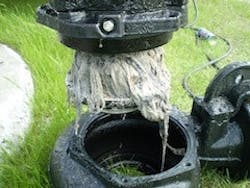Nondispersible Wipes Turning Sewers Into Nightmares Nationwide
Increasingly, wipes are causing serious issues for wastewater treatment system operators. Many of the wipes entering sewage systems are not dispersible and technically not flushable. The term “flushable wipes” was spawned in the 1980s when a consumer products company brought a latex-bonded air-laid wet wipe with polyester fibers to the market. The wipe was considered “flushable” since it could transit through the toilet, but with all those polyester fibers, it was not dispersible.
Wipes use is predominant in the U.S., Western Europe, Japan and Israel, but it is expanding on a global scale. In addition, the definition of what is flushable is not subject to industry guidelines, consumer instructions or government oversight. With the explosion of wipes on the market, there is significant consumer confusion about what is and is not flushable. Baby wipes, for example, are not flushable.
Deragging of pumps, valves and other equipment is adding maintenance and causing higher energy costs for sewer agencies around the world. For example, the city of Vancouver, Wash., which removed 429 tons of nonflushables in 2012, has gone to great lengths to document specific costs associated with this crisis:
• $78,000 per year for incremental crew labor for pump deragging
• $30,000 per year for incremental electricity costs for running clogged pumps
• $900,000 for new pumps to handle these materials
Additionally, troubleshooting and repairing equipment exposes workers to hazardous conditions, including needle sticks from hypodermic needles wrapped up in the rag balls.
Introduced in the early 2000s, wet wipes have become incredibly popular. The disposable wipes industry, which consists of consumer and commercial applications, is estimated at $6 billion. And forecasts estimate the rapid growth trend will continue.
Three field studies of pump station inlet screens conducted by the Association of the Nonwoven Fabrics Industry (INDA) and wastewater agencies have shown that only between 8 and 12% of flushed materials are products labeled “flushable”; significant portions included baby wipes (18%), nonflushable household wipes (12 to 14%) and nonflushable feminine hygiene products (13 to 18%).
Many agencies are beginning to tabulate the costs associated with the trend of rapidly accelerating wipes use, and several groups are working on solutions.
• The Water Environment Research Foundation (WERF)—in coordination with sewer agencies, engineers and equipment manufacturers—is conducting experiments on the impact of wipes on sewer systems.
• The Water Environment Federation (WEF) formed a work group on nondispersibles. Nearly 100 WEF volunteers and several wipe makers—as well as pump, screen and grinder manufacturers—are working on solutions.
• The Orange County Sanitation District (OCSD) in California implemented an outreach campaign titled “What2Flush” and allows other agencies to request and use the materials for their customers.
• In Maine, an award-winning public education campaign called “Save Your Pipes: Don’t Flush Baby Wipes” was launched. It is funded by INDA and wastewater agencies.
• In Santa Ana, Calif., a pump station with dry-prime pumps was severely impacted by wipes. Installation of a twin-shafted sewage grinder remediated the issue.
• Kimberly Clark has introduced a new substrate—the portion of the wipe that typically does not disperse—with further product development coming.
• Wastewater associations prompted Costco and its supplier Nice-Pak to place a larger “do not flush” symbol on packets of baby wipes. Nice-Pak came through, but other manufacturers have not followed suit.
• WEFTEC will host a special session dedicated to wipes. On Wednesday morning, look for session #500—“Non-Dispersibles, 3Ps and You: Who Decides What To Flush?”
How can this crisis be mitigated? There are three key tactics the wastewater community seems to be moving towards: public education, better technology and, as a last resort, new fees. New regulations or an outright ban are also mentioned, but seem unlikely—consumers love wipes, so they are here to stay.
The single most important solution is aggressive public education to teach consumers what to flush and what not to flush—and it is the most expensive tactic. Investment in technology and research is in order, both for the wipes industry and wastewater equipment manufacturers. Finally, sewer agencies already face a lack of resources, so a package fee on wipes or increased sewer fees may be needed to deal with the problem.
As with any crisis, it will take all of us working together to develop a suite of solutions. Collaboration is essential among the stakeholders—wastewater agencies and professionals, engineers, equipment manufacturers and wipes manufacturers.
